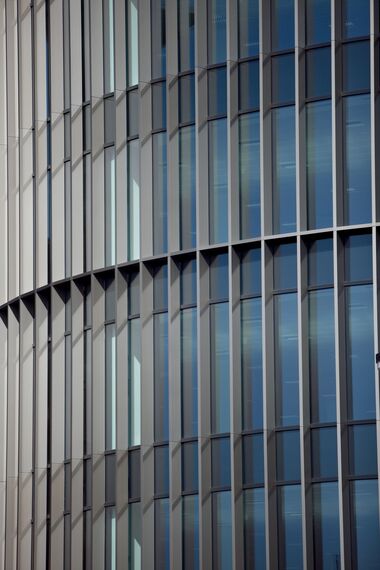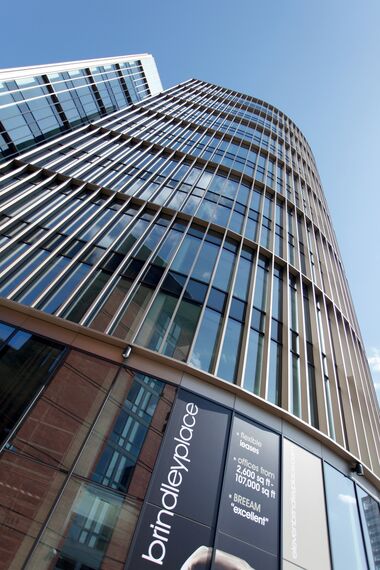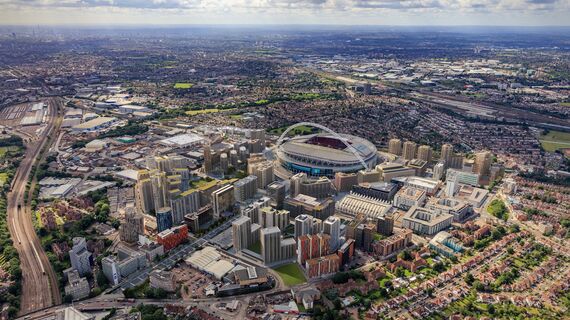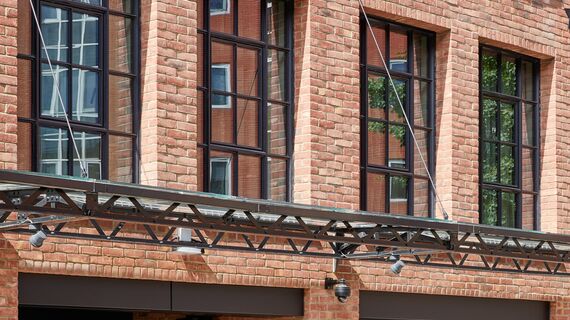- Glenn Howells Architects
Eleven Brindleyplace
Glenn Howells’ new office building is the last piece of a jigsaw in a long and large redevelopment saga. Brindleyplace, a seventeen-hectare site near Birmingham’s city center, has been transformed from a derelict, ex-industrial area into a vast new urban quarter. The story of this success, achieved by developers Argent, masterplans by Terry Farrell and John Chatwin, and the determination of the City Council to bring the site back into use, was not without difficulties. Brindleyplace in the 19th century formed part of Birmingham’s character and status as an industrial powerhouse. But like elsewhere in the UK, the manufacturing industry declined in the 20th century, and by the 1980s, the buildings on site were no longer in use. A major effort was needed to breathe new life into the assemblage of former factories. Three developers tried their luck, but the first two went bust. The economic crash of the early ‘90s didn’t help, but developers Argent, who bought the site for not much more than a peppercorn price, managed to achieve a tour de force in urban planning. What ties the new development together - despite the variety of styles and forms - is the masterplan’s objective to create a good pedestrian environment, along with permeable, arcaded ground floors to the buildings. CABE, Britain’s design watchdog, considers the overall development success and lauds its strong sense of place, public places, and response to the canal as the most important feature in the character of Brindleyplace.
LANDMARK
Glenn Howells’ new building was constructed on a difficult site. Roughly triangular-shaped and wedged behind a rather underwhelming hotel building, it had to respond to a brief asking for a landmark structure. While many of the buildings on the redevelopment site are faced in brick and are a consistent, lower height, Howells’ new office block is a different sort of animal. It is slender and tall, faced in glass in anodized frames, and is composed of two distinct shapes which are held together by a glazed core. A curved element follows the street to the west and ‘sweeps’ you into the new site, as project architect Michael Cruise describes it. A rectangular tower sits to the east and serves as a visual backbone. The Reynaers systems used on the façades – a customized solution based on the curtain wall systems CW 50 and CW 60, and CS 68 doors in bronze anodized aluminum – form part of a bespoke curtain wall design which was tested at Reynaers’ facilities in Duffel, Belgium. From the outset of the project, the fabricator Glamalco was closely involved in the design and development process. The glazing accentuates the building’s verticality which was an important design consideration for Glenn Howells Architects, who wanted to create an elegant landmark. Crucially, the system can be reglazed from the inside, a feature that makes it ‘future-proof’. To the east, north, and west, the building’s elevations have been fitted with aluminum fins which add depth to the surface but also play an important environmental role in providing shading and preventing solar gain.
DETAILING
When Brindleyplace was in its infancy and the first office buildings went up, large floor plates were built and resulted in an overprovision of such accommodation. This is why Eleven is different. The office space is designed to be occupied by small and medium-sized companies, and it is hoped that the creatives will take residence here. Developers Argent have moved their Birmingham Offices to the new building, and an operator is lined up for the ground floor bar and restaurant. While the building is a truly modern statement, the architects took great care to respond to the context using detailing. The anodized frames and fins to the glazing system are not simply powder-coated but vary in color; this gives them a warm and natural appearance, as Cruise proudly points out, and to some extent reflects the warmth of the brickwork of Brindleyplace’s Victorian buildings. Working with Reynaers on this was part of the building’s success and has made it a worthy contribution to and a landmark within Brindleyplace.
Used systems
Involved stakeholders
Architect
- Glenn Howells Architects
Fabricator
- Glamalco
Photographer
- Nick Short Photography
Other stakeholder
- BAM Construction (General contractors)
- Argent Group Plc (Investors)









